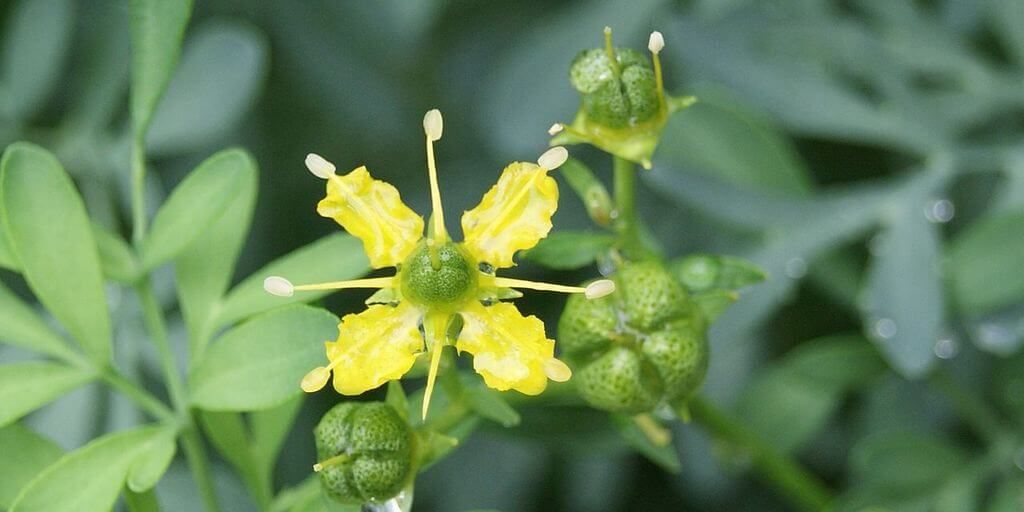Rue (Ruta graveolens) is a perennial herb belonging to the Rutaceae family, native to the Mediterranean region but cultivated in various parts of the world for its culinary, medicinal, and ornamental uses. More popularly known as “Common Rue” or “Herb of Grace“, Rue has a long history of traditional use dating back to ancient times, and it plays a role in various cultures and traditions.
A Brief History of Rue
For millennia, Ruta graveolens has held an important role in natural and folk medicinal wisdom. It also has a colorful history which we will explore in this article.
Rue was well-respected by Hippocrates for its medicinal qualities. Aristotle touted it as essential for calming nervousness. Pliny recorded that it was used by artists to encourage eye health. When tied in bunches, this plant, also known as “herb of grace,” was used in churches and cathedrals to sprinkle holy water. Rue was one of the active ingredients of Four Thieves’ Vinegar, which was said to protect the opportunists who stole from those suffering from the effects of the Black Death. It was sprinkled on the floors of courthouses and carried by judges to ward of the illness and fleas that so often afflicted the incarcerated poor.
The colloquial saying, “rue the day” is said to come from the discomfort caused by handling the leaves of Ruta graveolens. Its leaves are said to be the basis for the suit of clubs used on playing cards for centuries. This varied history only scratches the surface of this interesting and useful herb.
Native Habitat of Rue
Rue is thought to have come to southern Europe via northern Africa and the Mediterranean region. This hardy evergreen shrub then established itself throughout the continent and, with the help of British and Spanish colonialism, became a favorite in cottage gardens in the West Indies, India, Mexico and the United States. It is now a naturalized member of the flora of both North and South America and thrives easily in USDA growing zones 6 through 11.
Standing up to two feet tall, Rue’s little yellow flowers and green-gray stems and leaves can be found in culinary and medicinal herb gardens, butterfly habitats and growing of its own accord along roadways.
Key Facts About Rue
Key features of rue include:
Aromatic Leaves: Rue has distinctive bluish-green, deeply lobed leaves that are highly aromatic when crushed or bruised. The leaves emit a strong, pungent odor with a bitter, acrid taste which is characteristic of many plants in the Rutaceae family.
Yellow Flowers: In the summer, rue produces clusters of small, bright yellow flowers with prominent stamens. The flowers are attractive to pollinators such as bees and butterflies and add ornamental value to gardens and landscapes.
Culinary Use: Rue leaves are used sparingly as a culinary herb in some Mediterranean cuisines, particularly in Italian and Mediterranean dishes. The leaves are known for their strong, bitter flavor and are often used to add depth and complexity to dishes such as soups, stews, sauces and salads. However, rue is used in small quantities due to its potent flavor and potential toxicity in large amounts.
Medicinal Properties: Rue has a long history of use in traditional medicine for various health conditions. It contains several bioactive compounds, including alkaloids, flavonoids and volatile oils, which are believed to contribute to its medicinal properties. Rue has been used to alleviate digestive issues, menstrual disorders, respiratory ailments and skin conditions. It has also been used topically as a natural insect repellent and to soothe skin irritations.
Ornamental Plant: In addition to its culinary and medicinal uses, rue is often grown as an ornamental plant in gardens, borders, and herb gardens. It has attractive foliage, bright yellow flowers, and a bushy growth habit, making it a popular choice for adding texture, color, and fragrance to outdoor spaces.
Symbolism and Folklore: Rue has symbolic meaning in various cultures and traditions. It has been associated with protection, purification, and warding off evil spirits in folklore and superstition. Rue was historically used as a protective herb, worn as an amulet, or hung in doorways to ward off negative energy and bring good luck.
Rue Health Benefits
Rue (Ruta graveolens) has been traditionally used for various medicinal purposes, and its potential health benefits have been explored in folk medicine. It’s important to note that while rue has a history of traditional use, scientific research on its efficacy and safety is limited, and some compounds in rue may be toxic in high doses.
Here are some of the historical uses and potential health benefits associated with rue:
Digestive Health: Rue has been historically used to alleviate digestive issues, such as indigestion and gas. It was believed to have carminative properties that could help with bloating and discomfort. It is also used as a digestive tonic and to stimulate the appetite. It is a good source of flavonoids.
Anti-inflammatory Effects: Historically, Rue has been used for its anti-inflammatory properties to relieve the pain associated with the physical symptoms of complaints such as gout, rheumatism, and sciatica. It can be applied topically or consumed as a salad herb, to reduce inflammation associated with these various painful conditions.
Menstrual Issues: In traditional medicine, rue has been used to address menstrual problems, such as irregular periods and menstrual cramps. It was believed to have properties that could help to promote menstruation and regulate the menstrual cycle.
Respiratory Conditions: Rue has been employed in folk medicine for respiratory issues, including coughs and bronchitis. It was thought to have expectorant properties that could help clear the respiratory passages.
Nervous System Support: In traditional practices, rue has been used for its potential calming and sedative effects on the nervous system. It was believed to help alleviate anxiety and stress.
Antimicrobial Properties: Some studies have suggested that rue extracts may exhibit antimicrobial properties, which could potentially help combat certain types of bacteria.
Expel Worms: Some herbalists and traditional practitioners believed that rue had properties that could help expel worms. However, it’s crucial to note that the scientific evidence supporting the effectiveness of rue for expelling worms is limited, and its use for this purpose is not widely recommended.
How to Prepare Rue
Consuming rue (Ruta graveolens) raw is generally not recommended due to its potential toxicity.
Ruta graveolens tea or infusion can be sipped to calm the nerves, increase the appetite or to ease croupy symptoms. An oil made with Rue can be applied to areas suffering from sciatica or to ease chest congestion. Topical preparations are available to treat arthritis and joint pain.
If rue is to be used for culinary or medicinal purposes, it is typically done in small, controlled amounts and after appropriate processing. Cooking or drying the plant is believed to reduce its toxicity, but it’s crucial to exercise caution and adhere to recommended dosages. Rue has a strong flavor and is sometimes used sparingly as a seasoning in certain cuisines, but it should be approached with care.
Always take care when taking herbs and Read Our Disclaimer.
Rue Herb Notes / Side Effects
While rue has a rich history and cultural significance, it’s important to note that the plant contains potentially toxic compounds, particularly in high doses. Excessive consumption of rue leaves or ingestion of rue essential oil can cause adverse effects such as nausea, vomiting, abdominal pain, dizziness and photosensitivity.
Rue contains various compounds, including alkaloids and furanocoumarins, which can be toxic in high concentrations. These substances may cause adverse effects, including skin irritation, photosensitivity (sensitivity to sunlight) and gastrointestinal disturbances.
The toxic properties of rue can vary among individuals, and even small amounts of raw rue may lead to adverse reactions in some people. Symptoms of rue toxicity can include nausea, vomiting, abdominal pain, and skin irritation.
Women who are pregnant, or believe that they may be pregnant, should not use rue in any form. Its history as an emmenagogue suggests that it can induce miscarriage. Rue also has potential uterine-stimulating effects.
Rue should not be used in large dosages as it can cause some poisoning in sensitive people. Finally, the juice of the fresh plant is an irritant when applied to the skin in a concentrated area. People with sensitive skin should avoid topical application of rue.
Rue is a favorite food plant of specific butterfly species and makes a lovely addition to the garden but the gardener must exercise caution as the sun can cause a photosensitive reaction in the skin that was exposed to the sap. The resulting rash is reminiscent of poison ivy and can be a long-lasting annoyance.
Given the potential risks associated with raw rue consumption, it is strongly advised to consult with a knowledgeable healthcare professional or herbalist before using rue for any purpose, whether culinary or medicinal. They can provide guidance on safe usage and appropriate dosages based on individual health status and potential interactions with medications or other herbs.



Leave a Reply